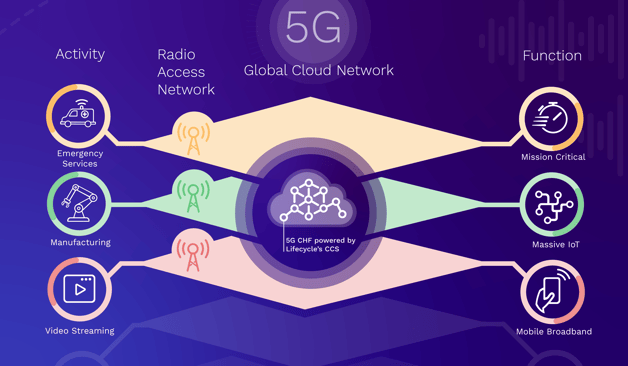Monetising 5G – It goes right to The Core?
5G networks will revolutionise the world around us; designed to enhance connectivity between connected devices and services and promising higher bandwidth, faster download speeds, ultra-low latency, more reliability, massive network capacity and increased availability to users.
As the industry transitions from existing 3G and 4G standards to 5G networks, exciting new opportunities are emerging for innovation, offering brand new services that were not possible before.
5G will transform business models and digital transactions, over many new and emerging devices. It will not only bring an increase in the volume of transactions; it will involve a massive variety of transactions. It will change the way that network services are created, deployed and monetised. Providers will be supported by an expanding ecosystem of wholesale business-to-business-to-customer or enterprise (B2B2x) solutions as they create and deploy exciting new services.
What is so different about 5G?
The architecture and design philosophy behind 5G differs quite significantly from 3G and 4G. 5G also brings exponential increases in both the volume and variety of usage events. Although not impossible, it is unlikely that any billing architecture designed or evolved for 3G and 4G will be adequate for a 5G ecosystem. Furthermore, the almost limitless nature of 5G service possibilities means a 3G or 4G rate table will be unlikely to support the huge diversity of 5G charging parameters and vectors. The Lifecycle Software approach, whilst still supporting and integrating with our 3G and 4G implementations, has been to develop for 5G, a complimentary, cloud-native billing architecture and Converged Charging System (CCS).

Adapt and innovate with a cloud native Billing Architecture
The evolution to 5G sees the replacement of the Evolved Packet Core (EPC). The 4G LTE EPC is replaced with a new 5G Core (5GC) that operates in a Service-Based Architecture (SBA). With 5GC, CSPs will be able to offer and manage a wide variety of content and services across a wide range of devices. These may include one-off purchases such as buying a movie, ongoing charges like a per-minute charge for a live video chat with a healthcare professional for example and metered charges based on message volume or device usage. Because of the demand for these differentiated services, providers will need to slice their network to provide very different experiences for their customers: one slice for low-cost, high-latency IoT traffic, another slice for high-cost, low-latency emergency response services for example.
5GC delivers the ability to segment the network’s service into logical slices. Each slice supports a specific set of business cases, and thus offers varying quality of service (QoS) depending on the demands placed on it by the business case. This slicing ability coupled with nearly instantaneous 5G speeds sets the stage for enhanced mobile broadband (eMBB) and brand new IoT opportunities that were not possible in 4G.
As new network slices are created, new billing and charging services need to be created to support those slices. These charging services must be designed to scale up and down seamlessly, move out of the core network and into the network’s edge for lower latency, apply different policies for security and quality, and so on.
Lifecycle Software’s cloud-native solutions run in containers with container orchestration (e.g., Kubernetes) and flexible APIs to facilitate collaboration with other solutions. Because it is cloud native, the Lifecycle Software CCS is optimised for the evolving 5G ecosystem of new IoT devices, network slicing and new business models. This ensures support for new pricing schemes and business models for millions of users making small transactions for many different services. Our flexible, automated cloud-based architecture enables new services to be launched quickly.
Optimise the billing experience with a Converged Charging System
To integrate with a 5GC network, a Converged Charging System (CCS) is essential. Lifecycle Software’s CCS provides the critical Charging Function (CHF) of the 5GC network and breaks down the traditional barriers between prepaid and post-paid services, enabling a single point of charging for all customers and services. It replaces the Online Charging System (OCS) for real-time rated services and also replaces network generated CDRs in a post-paid network. It means different services are merged into one itemised invoice to improve the end user’s billing experience.
With the Lifecycle Software’s CCS, the power of event data is harnessed in highly personalised billing. Event intelligence monitors the feed of events and outputs for consumption by the network providing a better understanding to act on end user behaviour. Filters and real-time checks can be used to trigger new workflows, providing a unique customer experience.
The Lifecycle Software cloud native CCS platform seamlessly integrates with existing Long-Term Evolution (LTE) services and the emerging 5G core Service-Based architecture (SBA), unlocking monetisation opportunities created by 5G, in both architectures.
We have a 20-year history of delivering OSS/BSS solutions into complex and hybrid environments. We specialise in making the new work with the old, so no revenue opportunity is allowed to be lost. If you are looking to unlock 5G monetisation opportunities on existing networks and/or emerging 5GC service-based architectures, please contact us to start the conversation.

